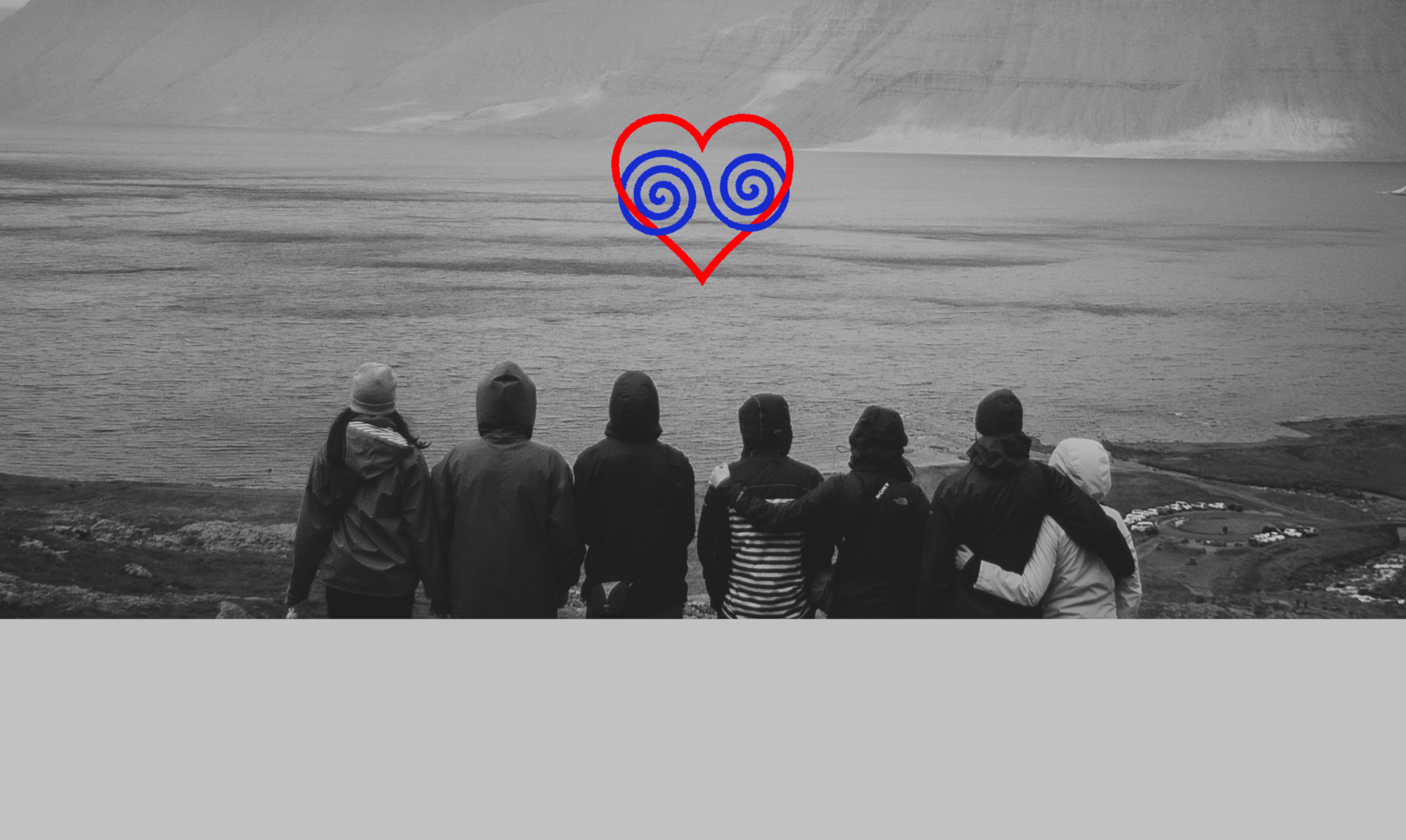Doubleface
There are some topics you simply cannot get around in multiple relationships.
One of these concerns one’s own self-image and one’s own role ascription(s).
Role-ascriptions from the outside – well – those are also abundant beyond multiple relationships: All we have to do is consult the TV program, a magazine, the Internet or our families – and we’ll get enough answers on how we “should be”.
Nevertheless, in the world of Mono- or rather Di-Amory¹, it is easier to manage one’s inner self – and thus our hidden conceptions of ourselves – as a private little kingdom, even to the extent of hiding our true motivations from our only life partner.
Why do I believe that this is difficult to achieve in multiple relationships in this way?
In my opinion, some of the values that underlie all forms of ethical non-monogamy (such as Poly- and Oligoamory) virtually exclude this, once a person really gets face to face with the implications of a genuine multiple relationship.
These “values” are no one-way streets: We do not only want our partners to (hopefully) acknowledge these, but we ourselves willingly choose the same canon of maximal integrity to bring the whole thing to life.
In particular, the values transparency, honesty and identification that I mentioned in Entry 3 will thus exert a certain interaction and reciprocity on us that we can hardly evade.
And while in a pure two-person relationship (i.e. as couples) we may be able to maintain a reasonably useful bond for several decades by hoping that our significant other will “guess” in a mystically romantic way all those things that would make us happy (which leaves us with an approximate 50: 50-chance to stumble from disappointment to fulfilment), this survival-mode will no longer be sufficient for multiple relationships.
That’s why “#communication” is so strongly emphasised in the world of non-monogamy, and that’s why I introduced in Entry 20 e.g. two communication philosophies behind which the principal realisation is: In order to communicate, in order to connect, I first of all have to figure out what those things are that I wish for myself.
And this pondering look into your own mirror will confront us with our self-image I mentioned at the beginning – and with our role ascriptions – whether we like it or not.
I’m writing “whether we like it or not” because every time we do this, even if only for a tiny moment, there will always emerge a radically honest “state of great clarity“, that will show us a glimpse of our own congruity or our ambiguity at that point in time concerning our deepest underlying motivation. However, how we will deal with this revelation, whether we quickly look away, lock it up and bury it, disguise it, ignore it, accept it, embrace it or even integrate it – that will have a significant impact upon our lives, upon our ability to relate – and thus, of course, upon (all) our relationships.
There is even a scientific basis for this. In his book “What we are – and what we could be” (S. Fischer, 2011) the neurobiologist Prof. Dr. Gerald Hüther explicates, that our brains, which are adjusted by evolutionary alignment to efficient energy management, favour”congruity” (consistency / coherence) as ideal condition. Any “incongruity” is thus reported as stress in terms of (strenuous) energy consumption – and it does not matter “where” this “incongruity” is perceived: regarding the behaviour of others or regarding our own motivations…
What is it that I , Oligotropos, author of this blog, want to point out to you? I think it’s time for a personal example.
Of course, everyone of us has quite a few self-chosen role ascriptions. Literally, we are wearing lots of different “hats” in everyday life and we even change them – depending on requirements – to some extent in rapid succession. Accordingly, we recurringly are probably partners, possibly parents, employees, supervisors, subordinates, friends, (kitchen table)psychologists, clients, buyers, customers, neighbours, club members, event visitors, creative minds, problem solvers, organisers, siblings, daughters or sons, teachers or students, etc.
And concerning all these roles we routinely adopt, it is likely that to a certain extent our demeanour will be more or less a bit different from our internal self-image: As employee, we are a little bit more friendly when talking to a customer on the phone than we would be if our daughter would peeve us with the same vanity for the third time; if we present our volunteer work at the town hall in order to receive financial support, we will probably appear more courageous and competent than we truly feel; if we step into the breach for a friend and strengthen his / her back, our advice may turn out to be more pugnacious than we would heed it ourselves – and so on.
In all those cases the above mentioned potential “in/congruity” already causes us to feel either somewhat unsettled or – on the contrary – to be in one’s element.
But, in fact, I would like to push a layer deeper than these “everyday hats”, because our internal self-image is, as briefly indicated above, always an essential part of our personal motivation – and thus is directly connected to the existential core-issue “What are those things that I personally (deeply/truly) wish for?”. Therefore finally the promised example:

I myself e.g. have a role ascription which I would like to call for this purpose the “White Knight“.
This “White-Knight-role” did (and probably still does) play an important part in several relationship-inceptions of mine. Since I describe myself (see “About me”) as heterosexual, cisgender and male, the advances of the “White Knight” were dedicated in my case towards the heterosexual, cisgender and female sex and often shaped the starting position for the famous “First Steps”. Accordingly, the “White Knight” was initially looking for an alleged “Damsel in distress”. Concerning the definition of “distress” the White Knight wasn’t to picky in regard to the circumstances: An acquaintance with a pesky (ex)boyfriend, a female friend with difficulties in moving home, but also a sad maiden with a hopelessly dramatic biography would suffice to call my “Knight” to the scene. The knight then proceeded to save the life of this threatened maiden from the impending rigours, to counteract the approaching chaos with order and – of course – to finally serve the lady to the best of his abilities and in the most faithful manner.
Let’s now briefly shed light on the part of my self-image (since I am, after all, a “Hero in my own movie“, too): On the one hand, we recognise my loyal, reliable, trustworthy and conscientious qualities – which I actually own in good measure.
But if I’m that aware of these qualities – why do I not immediately display these strengths during the initial relationship-building-process and promote myself by them – but rather choose this strangely oblique approach of the “White Knight” and his emergency response?
Because the other side of my self-image is that of a person who is not very likeable at first sight, who thus does not believe that he can draw the attention of a potential partner on the “free market” by merits of his own – and who is instead secretly hoping to find among the “Damsels in distress” more grateful, somewhat undemanding and thus allegedly easier “prey”.
Which brings me straight back to my “White-Knight role”, which therefore also has a “dark” side, a hidden agenda, which of course isn’t displayed openly to the respectively courted “Maiden”.
However, if a relationship – the reason for which the “White Knight” was originally activated – intensifies, my inner chevalier can turn into a somewhat awkward companion and niggling participant in an emerging relationship, who expects a strange kind of enduring thankfulness and a persistent unobtrusiveness from his rescued object of desire (Phew. That was self-honest to a degree that probably by now every woman I’ve ever courted has recognised more than a just a bit…).
What I liked to show, nonetheless, is how a self-chosen “role ascription” is rooted in a deep internal self-image, which in fact consists of several components itself, which then in turn unite to generate our displayed role – where these hidden incongruences will cause quite an elusive demeanour. Which in my case can turn the initial impression of a welcome and loyal supporter medium-term into its shadow of a self-righteous nagger.
One layer deeper down than the meanwhile somewhat familiar and well researched role ascription of the “White Knight” I keep another role, which I have baptised the “Vampire Lord “. That this ascription possesses only few positive qualities already suggests its literally “undead” nature, for it “craves for the living”. Thus, the “Vampire Lord” is a role that I’m not fully conscious about yet and which I therefore still exercise with lesser awareness than the aforementioned “Knight-role”. The “Vampire Lord”, too, is based on my biographically grown conviction that I am an “unlovable being”. Its neediness for human love has increased since my childhood for more than four decades to such an extent that this role is potentially able to get me regularly into a real mess concerning any kind of relationship building. In the course of this it can even happen that I toss my true self-image completely overboard and – overcome by neediness and craving for any kind of human connection – push my limits to the edge of self-harm (compliance, self-abandonment, hangover included). Anyone who has read in “About me” that I qualify as highly sensitive (SPS), may know how dreadful the consequences can appear to me in the aftermath.
“Healthy relationships” – such as those to which I invite by means of my Oligoamory-project ” aren’t established by the “White Knight” or “Vampire Lord”. But both are not entirley useless as well – since they can serve as genuine examples here.
“That Oligotropos, that guy has problems…“, some may now think. Well.
Concerning this matter and its psychic dimension I recommend the graphic novel and the movie “I Kill Giants“², in which the story of the15 year old teenager Barbara and her family are told (fiction): Her brother mentally and morally has immersed himself into first-person shooter gaming worlds, and her older sister has assumed out of necessity the role of “family caregiver”. Meanwhile, young Barbara has chosen the seemingly odd role of “village-shaman”, protecting the small town they all live in against a lingering threat of giant-attacks by means of runes, magic weapons, and protective charms. The role assumption and the identification of Barbara with her part as “protective shaman” is excellently portrayed in both novel and movie. She cultivates her “heroic” – and in parts even somewhat currish – image right down to her everyday language and her way of dealing with school and siblings. As a small-town resident with only a few mates of the same age to choose from, Barbara’s “shaman role” fulfills appropriately her need concerning creativity, spirit for adventure, strong self-esteem and non-normative (protest) behaviour. But, of course, even to her, this is only one side of the motivation behind her internal self-image and behind her compiled “role”. Because – the title already reveals it – she also has to face yet completely different monsters in herself, as one would usually suspect at first glance concernig that somewhat unkempt teenager…
How far our internal self-image and our deepest hidden motivations can deviate from our self-imposed role ascriptions, the fates of 28-year-old Anna Sorokin and 31-year-old bLogger Marie Sophie Hingst have revealed this year. Both had created a completely alternative personality, because their own internal self-image probably seemed too colorless, too commonplace and therefore not very promising to them. Both biographies, which in one case led to a long prison sentence and regarding the other case to a tragic death, prove the unbelievable energetic efforts we humans are able to muster to avoid facing our own inner truths, while on the outside the values of our nominal-actual self-comparison drifts further and further apart.
I do not consider the slight difference in the age of both women to be a coincidence, since we probably all have only a limited span in our lives, how long we can deny our inner realities before they become untenable for us or our environment.
Maria Sophie Hingst, who shortly before she committed suicide told her mother concerning her (false) self-image, which by then was dismantled by the press, she felt “as if she had been skinned” – and thus proved in a drastic way why transparency, honesty and identification are no negotiable marginalia in any kind of relationship (even in relationship with yourself!).
To really create “good” relationships, our self-acknowledgement is of the utmost importance. Exploring and examining our innermost motivations which are directly related to our self-image is a task that we should devote ourselves to with serenity and care. And yes, this concerns in particular those aspects which we ourselves do not think off as wonderful or exciting. It is fundamental in respect of our own sincerity towards ourselves as well as the very basis for the opportunity to entrust ourselves to our loved ones.
Because no matter whether we occasionally consider ourselves to be the black flittermouse-man, the White Knight, the rabbit-shaman or a millionaire’s daughter: Our chosen loved ones – or the persons we whish to relate to – instinctively invariably relate to the person we are in our deepest inner self.
That’s why it’s time – to quote Cindy Lauper³ – that we always dare to let our true colours shine.
¹ I call classic “Mono-Amory” in this case “Di-Amory” since it concerns a relationship-mode containing exactly two (Greek prefix “Di-”, two) persons.
² I do not want to spoil the experience of the content – neither of the graphic novel nor the movie – accordingly I put the Wikipedia-Link here in the footer:
³ Cindy Lauper “True Colours” (Song, Lyrics)
Thanks to Afrikit on Pixabay for the photo.

